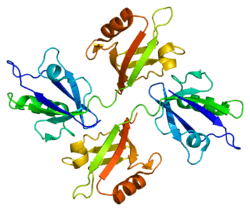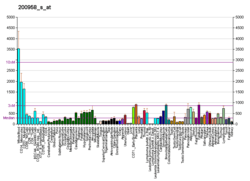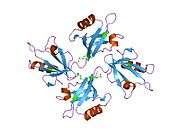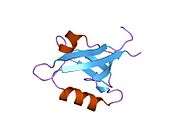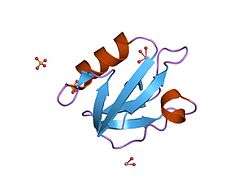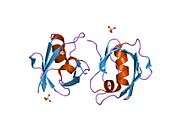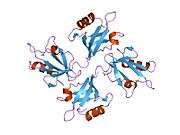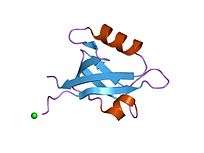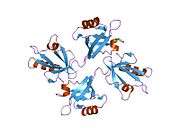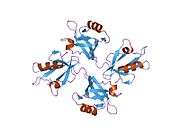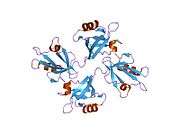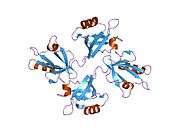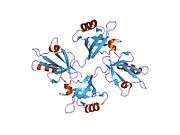Syntenin-1
Syntenin-1 is a protein that in humans is encoded by the SDCBP gene.[5]
Function
The protein encoded by this gene was initially identified as a molecule linking syndecan-mediated signaling to the cytoskeleton. The syntenin protein contains tandemly repeated PDZ domains that bind the cytoplasmic, C-terminal domains of a variety of transmembrane proteins. This protein may also affect cytoskeletal-membrane organization, cell adhesion, protein trafficking, and the activation of transcription factors. The protein is primarily localized to membrane-associated adherens junctions and focal adhesions but is also found at the endoplasmic reticulum and nucleus. Alternative splicing results in multiple transcript variants encoding different isoforms.[6]
Interactions
References
- 1 2 3 GRCh38: Ensembl release 89: ENSG00000137575 - Ensembl, May 2017
- 1 2 3 GRCm38: Ensembl release 89: ENSMUSG00000028249 - Ensembl, May 2017
- ↑ "Human PubMed Reference:".
- ↑ "Mouse PubMed Reference:".
- ↑ Grootjans JJ, Zimmermann P, Reekmans G, Smets A, Degeest G, Dürr J, David G (January 1998). "Syntenin, a PDZ protein that binds syndecan cytoplasmic domains". Proc Natl Acad Sci USA. 94 (25): 13683–8. doi:10.1073/pnas.94.25.13683. PMC 28366. PMID 9391086.
- ↑ "Entrez Gene: SDCBP syndecan binding protein (syntenin)".
- ↑ Lin D, Gish GD, Songyang Z, Pawson T (February 1999). "The carboxyl terminus of B class ephrins constitutes a PDZ domain binding motif". J. Biol. Chem. 274 (6): 3726–33. doi:10.1074/jbc.274.6.3726. PMID 9920925.
- 1 2 Hirbec H, Francis JC, Lauri SE, Braithwaite SP, Coussen F, Mulle C, Dev KK, Coutinho V, Meyer G, Isaac JT, Collingridge GL, Henley JM, Couthino V (February 2003). "Rapid and differential regulation of AMPA and kainate receptors at hippocampal mossy fibre synapses by PICK1 and GRIP". Neuron. 37 (4): 625–38. doi:10.1016/s0896-6273(02)01191-1. PMC 3314502. PMID 12597860.
- ↑ Hirbec H, Perestenko O, Nishimune A, Meyer G, Nakanishi S, Henley JM, Dev KK (May 2002). "The PDZ proteins PICK1, GRIP, and syntenin bind multiple glutamate receptor subtypes. Analysis of PDZ binding motifs". J. Biol. Chem. 277 (18): 15221–4. doi:10.1074/jbc.C200112200. PMID 11891216.
- 1 2 Geijsen N, Uings IJ, Pals C, Armstrong J, McKinnon M, Raaijmakers JA, Lammers JW, Koenderman L, Coffer PJ (August 2001). "Cytokine-specific transcriptional regulation through an IL-5Ralpha interacting protein". Science. 293 (5532): 1136–8. doi:10.1126/science.1059157. PMID 11498591.
- ↑ Jannatipour M, Dion P, Khan S, Jindal H, Fan X, Laganière J, Chishti AH, Rouleau GA (August 2001). "Schwannomin isoform-1 interacts with syntenin via PDZ domains". J. Biol. Chem. 276 (35): 33093–100. doi:10.1074/jbc.M105792200. PMID 11432873.
- 1 2 Tomoda T, Kim JH, Zhan C, Hatten ME (March 2004). "Role of Unc51.1 and its binding partners in CNS axon outgrowth". Genes Dev. 18 (5): 541–58. doi:10.1101/gad.1151204. PMC 374236. PMID 15014045.
- ↑ Chen F, Du Y, Zhang Z, Chen G, Zhang M, Shu HB, Zhai Z, Chen D (April 2008). "Syntenin negatively regulates TRAF6-mediated IL-1R/TLR4 signaling". Cell. Signal. 20 (4): 666–74. doi:10.1016/j.cellsig.2007.12.002. PMID 18234474.
- ↑ "Results - mentha: the interactome browser". mentha.uniroma2.it. Retrieved 2017-05-04.
Further reading
- Bass MD, Humphries MJ (2002). "Cytoplasmic interactions of syndecan-4 orchestrate adhesion receptor and growth factor receptor signalling". Biochem. J. 368 (Pt 1): 1–15. doi:10.1042/BJ20021228. PMC 1222989. PMID 12241528.
- Harrod TR, Justement LB (2003). "Evaluating function of transmembrane protein tyrosine phosphatase CD148 in lymphocyte biology". Immunol. Res. 26 (1–3): 153–66. doi:10.1385/IR:26:1-3:153. PMID 12403354.
- Sarkar D, Boukerche H, Su ZZ, Fisher PB (2005). "mda-9/syntenin: recent insights into a novel cell signaling and metastasis-associated gene". Pharmacol. Ther. 104 (2): 101–15. doi:10.1016/j.pharmthera.2004.08.004. PMID 15518882.
- "Letter: The condition of psychiatry". N. Engl. J. Med. 292 (18): 982. 1975. doi:10.1056/NEJM197505012921826. PMID 1117941.
- Lin JJ, Jiang H, Fisher PB (1998). "Melanoma differentiation associated gene-9, mda-9, is a human gamma interferon responsive gene". Gene. 207 (2): 105–10. doi:10.1016/S0378-1119(97)00562-3. PMID 9511750.
- Torres R, Firestein BL, Dong H, Staudinger J, Olson EN, Huganir RL, Bredt DS, Gale NW, Yancopoulos GD (1999). "PDZ proteins bind, cluster, and synaptically colocalize with Eph receptors and their ephrin ligands". Neuron. 21 (6): 1453–63. doi:10.1016/S0896-6273(00)80663-7. PMID 9883737.
- Lin D, Gish GD, Songyang Z, Pawson T (1999). "The carboxyl terminus of B class ephrins constitutes a PDZ domain binding motif". J. Biol. Chem. 274 (6): 3726–33. doi:10.1074/jbc.274.6.3726. PMID 9920925.
- Fernández-Larrea J, Merlos-Suárez A, Ureña JM, Baselga J, Arribas J (1999). "A role for a PDZ protein in the early secretory pathway for the targeting of proTGF-alpha to the cell surface". Mol. Cell. 3 (4): 423–33. doi:10.1016/S1097-2765(00)80470-0. PMID 10230395.
- Fialka I, Steinlein P, Ahorn H, Böck G, Burbelo PD, Haberfellner M, Lottspeich F, Paiha K, Pasquali C, Huber LA (1999). "Identification of syntenin as a protein of the apical early endocytic compartment in Madin-Darby canine kidney cells". J. Biol. Chem. 274 (37): 26233–9. doi:10.1074/jbc.274.37.26233. PMID 10473577.
- Grootjans JJ, Reekmans G, Ceulemans H, David G (2000). "Syntenin-syndecan binding requires syndecan-synteny and the co-operation of both PDZ domains of syntenin". J. Biol. Chem. 275 (26): 19933–41. doi:10.1074/jbc.M002459200. PMID 10770943.
- Koroll M, Rathjen FG, Volkmer H (2001). "The neural cell recognition molecule neurofascin interacts with syntenin-1 but not with syntenin-2, both of which reveal self-associating activity". J. Biol. Chem. 276 (14): 10646–54. doi:10.1074/jbc.M010647200. PMID 11152476.
- Zimmermann P, Tomatis D, Rosas M, Grootjans J, Leenaerts I, Degeest G, Reekmans G, Coomans C, David G (2001). "Characterization of syntenin, a syndecan-binding PDZ protein, as a component of cell adhesion sites and microfilaments". Mol. Biol. Cell. 12 (2): 339–50. doi:10.1091/mbc.12.2.339. PMC 30947. PMID 11179419.
- Jannatipour M, Dion P, Khan S, Jindal H, Fan X, Laganière J, Chishti AH, Rouleau GA (2001). "Schwannomin isoform-1 interacts with syntenin via PDZ domains". J. Biol. Chem. 276 (35): 33093–100. doi:10.1074/jbc.M105792200. PMID 11432873.
- Geijsen N, Uings IJ, Pals C, Armstrong J, McKinnon M, Raaijmakers JA, Lammers JW, Koenderman L, Coffer PJ (2001). "Cytokine-specific transcriptional regulation through an IL-5Ralpha interacting protein". Science. 293 (5532): 1136–8. doi:10.1126/science.1059157. PMID 11498591.
- Hirbec H, Perestenko O, Nishimune A, Meyer G, Nakanishi S, Henley JM, Dev KK (2002). "The PDZ proteins PICK1, GRIP, and syntenin bind multiple glutamate receptor subtypes. Analysis of PDZ binding motifs". J. Biol. Chem. 277 (18): 15221–4. doi:10.1074/jbc.C200112200. PMID 11891216.
- Koo TH, Lee JJ, Kim EM, Kim KW, Kim HD, Lee JH (2002). "Syntenin is overexpressed and promotes cell migration in metastatic human breast and gastric cancer cell lines". Oncogene. 21 (26): 4080–8. doi:10.1038/sj.onc.1205514. PMID 12037664.
- Biederer T, Sara Y, Mozhayeva M, Atasoy D, Liu X, Kavalali ET, Südhof TC (2002). "SynCAM, a synaptic adhesion molecule that drives synapse assembly". Science. 297 (5586): 1525–31. doi:10.1126/science.1072356. PMID 12202822.
This article is issued from
Wikipedia.
The text is licensed under Creative Commons - Attribution - Sharealike.
Additional terms may apply for the media files.
